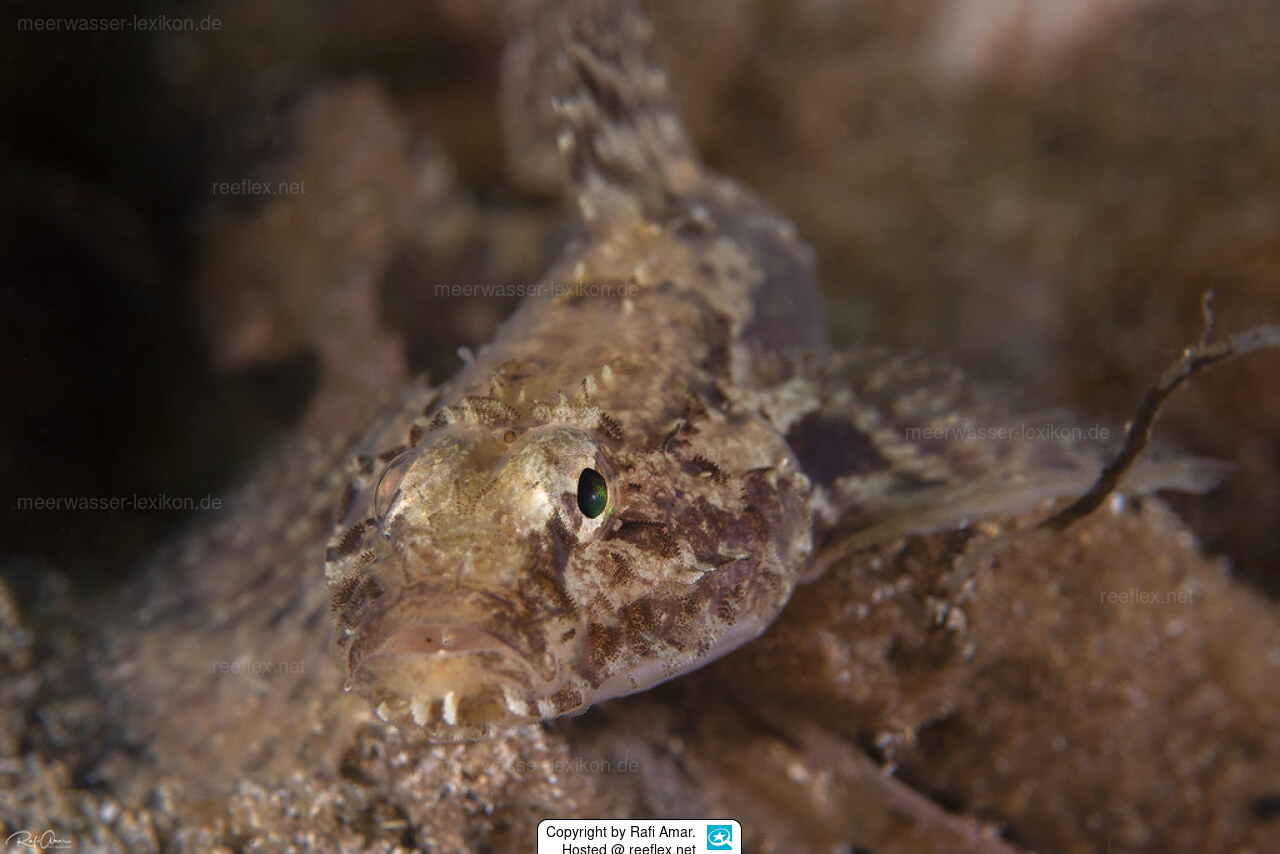Info
Callogobius depressus is a brown goby with narrow brown lines on the body forming a net pattern, the upper half of the pectoral fins are black.
Females have white patches on the dorsal and caudal fins.
The flat headed goby has a "pushed in" head with several distinct raised papilla flaps in horizontal and vertical rows on the head.
The transverse lobe behind each eye is short, its length is about the distance between the lobes.
This species is difficult to distinguish from the related species Callogobius mucosus.
This goby is found in shallow rocky reefs, including estuaries, where it is mostly hidden under rocks or in narrow ledges.
Callogobius depressus differs from Callogobius mucosus, which has the same geographical distribution, by having a flatter head, a less elongated body and a lighter colouring.
Both species are flattened, have skin crests on the head, a rounded tail and can produce abundant head mucus when disturbed.
They are also common and hide under rocks during the day.
Habitat: Soft sedimentary soils in front of rocks.
One specimen was found in Beaufort, South Carolina, USA on 23 April 1929!
Synonyms:
Gobius depressus (Ramsay & Ogilby, 1886)
Gunnamatta insolita (Whitley, 1928)
Jumping guard
A jumping guard prevents (nocturnal) fish from jumping out.
Wrasses, blennies, hawkfishs and gobies jump out of an unprotected tank in fright if their night rest is disturbed, unfortunately these jumpers are found dried up in the morning on carpets, glass edges or later behind the tank.
https://www.korallenriff.de/en/article/1925_5_Jump_Protection_Solutions_for_Fish_in_the_Aquarium__5_Net_Covers.html
A small night light also helps, as it provides the fish with a means of orientation in the dark!
Females have white patches on the dorsal and caudal fins.
The flat headed goby has a "pushed in" head with several distinct raised papilla flaps in horizontal and vertical rows on the head.
The transverse lobe behind each eye is short, its length is about the distance between the lobes.
This species is difficult to distinguish from the related species Callogobius mucosus.
This goby is found in shallow rocky reefs, including estuaries, where it is mostly hidden under rocks or in narrow ledges.
Callogobius depressus differs from Callogobius mucosus, which has the same geographical distribution, by having a flatter head, a less elongated body and a lighter colouring.
Both species are flattened, have skin crests on the head, a rounded tail and can produce abundant head mucus when disturbed.
They are also common and hide under rocks during the day.
Habitat: Soft sedimentary soils in front of rocks.
One specimen was found in Beaufort, South Carolina, USA on 23 April 1929!
Synonyms:
Gobius depressus (Ramsay & Ogilby, 1886)
Gunnamatta insolita (Whitley, 1928)
Jumping guard
A jumping guard prevents (nocturnal) fish from jumping out.
Wrasses, blennies, hawkfishs and gobies jump out of an unprotected tank in fright if their night rest is disturbed, unfortunately these jumpers are found dried up in the morning on carpets, glass edges or later behind the tank.
https://www.korallenriff.de/en/article/1925_5_Jump_Protection_Solutions_for_Fish_in_the_Aquarium__5_Net_Covers.html
A small night light also helps, as it provides the fish with a means of orientation in the dark!







 Rafi Amar, Israel
Rafi Amar, Israel





















